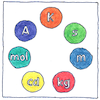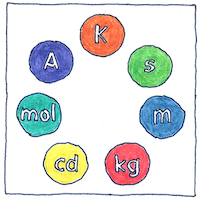John Wilkins (and the
French Revolution)
metrology

|
Metric system
John Wilkins recognized that a standard system of measurement derived from something natural and measurable would reduce the difficulty of conducting trade between countries and proposed a system of tenths for magnitudes, weights, and values based on the length of a pendulum adjusted to swing every second such that subunits—tenths, hundredths, and multiples of ten, one hundred, and so on— and the standard units for volumes, weights, and values would be derived from the standard unit of length. A hundred years went by until the French revolted against abuse of arbitrary units of measurement by the privileged classes, and established, in 1799, metric units for length, area, and volume, to which were later added units for liquid, mass, and electrical amperage, voltage, resistance, power, capacitance, and charge. The French term metre was based on the Greek métron, which means measure.
Eighths
John Wilkins preferred a system of eighths because eight is more easily divided than ten but he deferred to the acceptance of counting based on ten, and the success of tenths in decimal arithmetic as Simon Stevin described in 1585. Wilkins also recognized the desirability of deriving the standard length from the longitude of the earth but admitted that this would be impractical. Christopher Wren suggested deriving the standard length from the pendulum, time being theoretically related to longitude and the revolution of the earth.
Units
John Wilkins dismissed the use of the barleycorn as the legal standard for length and weight in England. “The magnitude and weight of it may be so various in several times and places, as will render it incapable of serving for this purpose.” His standard length based on the pendulum was less than one percent shorter than a meter. The names of his proposed units were common English words; his standard length being called a standard. One tenth of a standard was a foot; one tenth of a foot was an inch; one hundred standards was a furlong; one thousand standards was a mile; and ten miles was a league.
Conversion
I’d walk one point six oh nine three four four kilometers in your size twenty three point eight centimeter shoes to feel your pain as a four on a scale of ten, but I have no idea how our city blocks add up to kilometers, and my size twenty seven point nine centimeter feet wouldn’t fit, literally, into your clogs, so my conversion will need to remain metaphorical. I hope to the nth degree that that’s good enough.
Metric prefixing
whole yotta going on zetta right there exactly peta pet tera infirma giga me a minute from alpha to omega kilo minute, kilo hour hecto, where was I? decadent decimate a centi saved is a centi earned millipede microbrew nano nano pico de gallo the femto vote atto boy zepto your mouth don’t dongle your yoctongle



Florence Pretz of Kansas City invented the Billiken in 1908 as “the god of things as they ought to be.” Establishing the metric system was a success against things as they ought not be. So many other aspects of our lives are more irrational and heterogeneous.
After the French revolution, the Commission of Weights and Measures included the Marquis de Condorcet, Pierre-Simon Laplace, Adrien-Marie Legendre, Antoine Lavoisier, and Jean-Charles de Borda. The proper name for the modern metric system is the International System of Units, or, in French, le Système International d’Unités, with the abbreviation SI.
The meter preceded both John Wilkins’ work and the French revolution. Marin Mersenne measured the length of the seconds pendulum in 1644; the Royal Society proposed that it should be the standard unit of length in 1660; Tito Livio Burattini proposed that it should be called a meter in 1675.
See also in The book of science:
Readings in wikipedia:
Other readings: